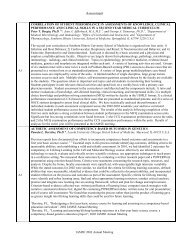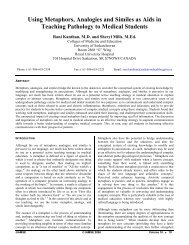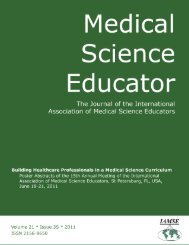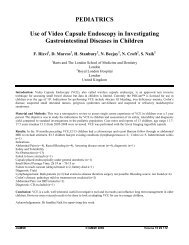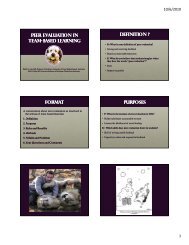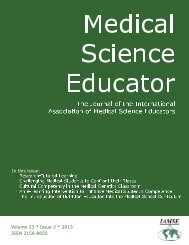Click here to view complete journal in pdf-format - IAMSE
Click here to view complete journal in pdf-format - IAMSE
Click here to view complete journal in pdf-format - IAMSE
You also want an ePaper? Increase the reach of your titles
YUMPU automatically turns print PDFs into web optimized ePapers that Google loves.
METHODS<br />
The new curriculum began <strong>to</strong> implement <strong>in</strong> 2009.<br />
After 2009, All the medical students <strong>in</strong> our hospital<br />
were enrolled <strong>in</strong> this tra<strong>in</strong><strong>in</strong>g program. The<br />
simulation based cl<strong>in</strong>ical skills tra<strong>in</strong><strong>in</strong>g was<br />
practiced <strong>in</strong> the cl<strong>in</strong>ical skills lab. So far, t<strong>here</strong> were<br />
215 medical students have been tra<strong>in</strong><strong>in</strong>g <strong>in</strong> this<br />
program.<br />
RESULTS<br />
T<strong>here</strong> are 70 rout<strong>in</strong>e technical procedures which a<br />
medical student is expected <strong>to</strong> be competent <strong>to</strong><br />
perform before graduat<strong>in</strong>g from our medical school.<br />
For each procedure, the tra<strong>in</strong><strong>in</strong>g will <strong>in</strong>clude 4<br />
steps. Step 1, Study the related knowledge. In this<br />
step, the student will attend a didactic tra<strong>in</strong><strong>in</strong>g<br />
session on <strong>in</strong>dications, risks and complications,<br />
procedural technique, post-procedure<br />
<strong>in</strong>terpretation, and a step-by-step demonstration of<br />
this procedure on the simula<strong>to</strong>r. All students are<br />
required <strong>to</strong> pass a multiple choice written<br />
exam<strong>in</strong>ation prior <strong>to</strong> enter next step. Step2,<br />
Simulation based tra<strong>in</strong><strong>in</strong>g. The students will<br />
perform the procedure on the simula<strong>to</strong>rs under the<br />
guidance of a full time teacher until they f<strong>in</strong>ished<br />
mastery learn<strong>in</strong>g on this procedure and pass the<br />
exam<strong>in</strong>ation. Step 3, Perform on patients. Different<br />
from the western countries, students will study 8<br />
years <strong>in</strong> our medical school. In the last 3 year, they<br />
will rotate as clerkship and <strong>in</strong>tern. Depend on the<br />
<strong>in</strong>vasiveness of the procedure; students may<br />
perform some of non-<strong>in</strong>vasive or less <strong>in</strong>vasive<br />
procedures on the patients, such as physical<br />
exam<strong>in</strong>ation, IV puncture. Student may be an<br />
assistant or an observer <strong>to</strong> participate some <strong>in</strong>vasive<br />
procedures. In this stage, each student must<br />
perform or observe a certa<strong>in</strong> number of the<br />
procedure. Step 4, F<strong>in</strong>al test. All students will<br />
undertake the cl<strong>in</strong>ical skills test before they<br />
graduate. The test will cover all 70 rout<strong>in</strong>e technical<br />
procedures. Students will be required <strong>to</strong> perform 10<br />
<strong>to</strong> 15 randomized choose procedures on simula<strong>to</strong>r.<br />
CONUSIONS<br />
The ‘Curriculum for Cl<strong>in</strong>ical Skills Repeat Tra<strong>in</strong><strong>in</strong>g’<br />
is not <strong>to</strong> replace real cl<strong>in</strong>ical patient experiences.<br />
Our experience demonstrated that the new<br />
curriculum has <strong>in</strong>corporated simulation based<br />
cl<strong>in</strong>ical skills tra<strong>in</strong><strong>in</strong>g <strong>in</strong><strong>to</strong> the traditional medical<br />
curriculum. Under this project, the cl<strong>in</strong>ical skills<br />
have been tra<strong>in</strong>ed repeatedly at different time <strong>in</strong><br />
various ways; it can improve the students’<br />
performance.<br />
Curriculum Abstract ID: 145<br />
INTEGRATION ON ALL LEVELS: INTER-<br />
PROFESSIONAL EDUCATION FOR<br />
MEDICAL AND PHYSICIAN ASSISTANT<br />
STUDENTS<br />
Elizabeth Kachur 1 , Donald Kollisch 1 , David Lau 1 ,<br />
Karen Adamo-Henry 1 , Paul Foster 1 , Jose<br />
Fernandez 1 , Vanessa Jenn<strong>in</strong>gs 1 , Demian Szyld 2,<br />
1 Sophie Davis School of Biomedical Education at<br />
The City College of New York, 2 New York<br />
Simulation Center for the Health Sciences, USA<br />
PURPOSE<br />
A pilot project was organized a. To explore an Interprofessional<br />
Education (IPE) model that utilizes<br />
small group teach<strong>in</strong>g, Standardized Patients (SPs), a<br />
multi-visit cont<strong>in</strong>uity case (illustrat<strong>in</strong>g the<br />
biopsychosocial aspects of diabetes & cardiac<br />
disease) and the technological opportunities of a<br />
simulation center. b. To enhance the relationship<br />
between two departments with<strong>in</strong> one <strong>in</strong>stitution.<br />
This poster will describe the program and elaborate<br />
on the evaluation results.<br />
METHODS<br />
The Sophie Davis School of Biomedical Education<br />
(SDSBE) <strong>in</strong>cludes a BS/MD and a Physician<br />
Assistant (PA) program. Despite co-location and<br />
shared adm<strong>in</strong>istrative oversight, students have not<br />
had prior opportunities <strong>to</strong> learn <strong>to</strong>gether. This fullday<br />
program consisted of a lecture and panel on the<br />
Patient-Centered Medical Home (PCMH) and<br />
Team-Based Care as well as a small group SP<br />
exercise. The latter <strong>in</strong>cluded assessment and<br />
<strong>in</strong>tervention tasks typical <strong>in</strong> the care of chronically<br />
ill patients: establish<strong>in</strong>g care, compliance issues,<br />
loss of <strong>in</strong>surance and hospitalization follow-ups.<br />
Small groups were formed consist<strong>in</strong>g of three<br />
BS/MD and PA student pairs and faculty from each<br />
profession. The audio-visual technologies available<br />
at a modern cl<strong>in</strong>ical skills center allowed for<br />
unobtrusive observations of SP <strong>in</strong>teractions and<br />
dynamic group discussions.<br />
RESULTS<br />
Students from both programs demonstrated<br />
significant learn<strong>in</strong>g ga<strong>in</strong>s as evidenced through preand<br />
post-<strong>in</strong>tervention surveys and narrative<br />
responses. Satisfaction with the SP small group<br />
session far outweighed the perceived value of the<br />
prepara<strong>to</strong>ry read<strong>in</strong>g, the lecture and the panel.<br />
Faculty and student program evaluations revealed a<br />
strong desire <strong>to</strong> expand the exercise and make IPE a<br />
rout<strong>in</strong>e element of each tra<strong>in</strong><strong>in</strong>g program.<br />
Medical Science Educa<strong>to</strong>r © <strong>IAMSE</strong> 2012 Volume 22(4S) 292



